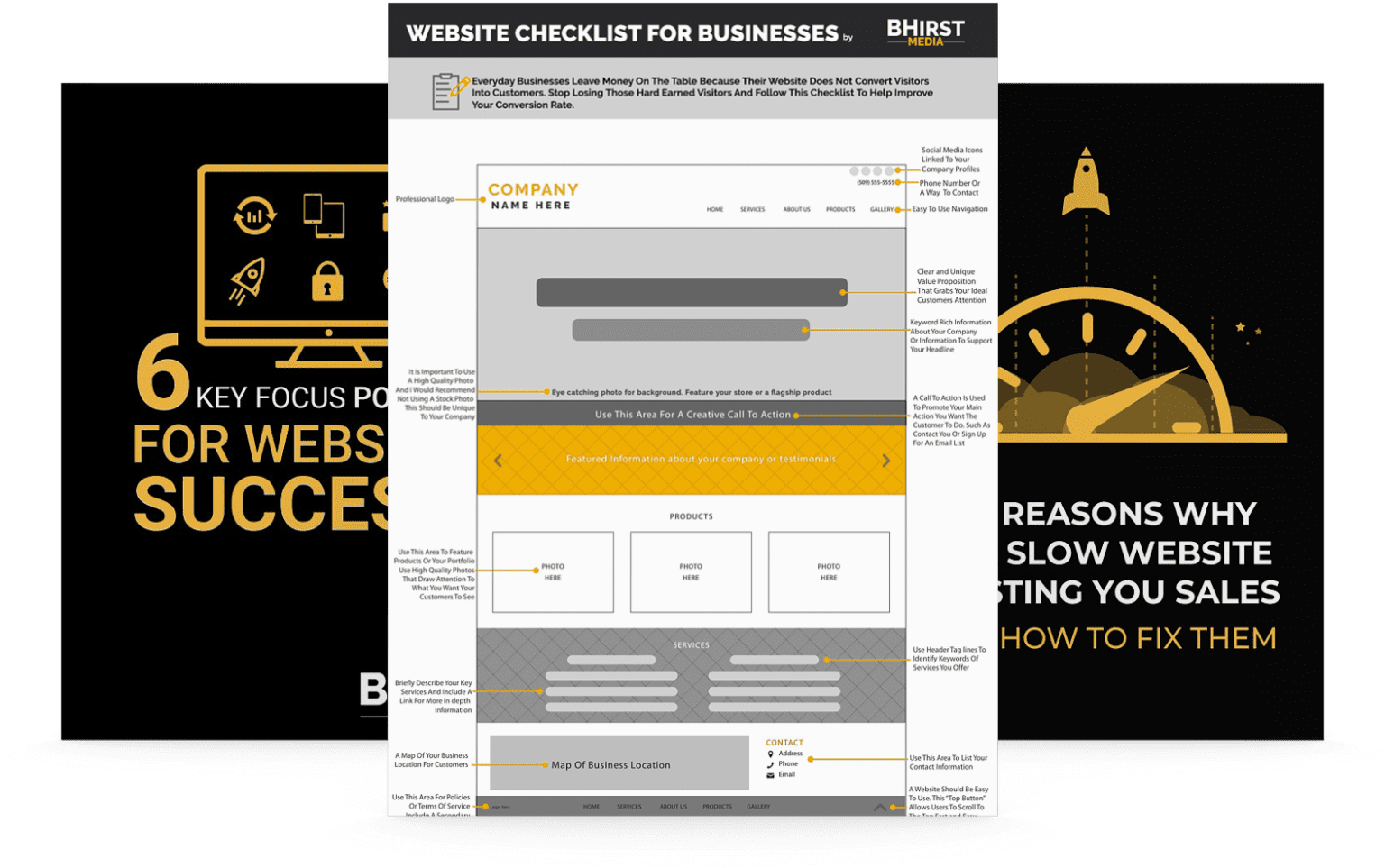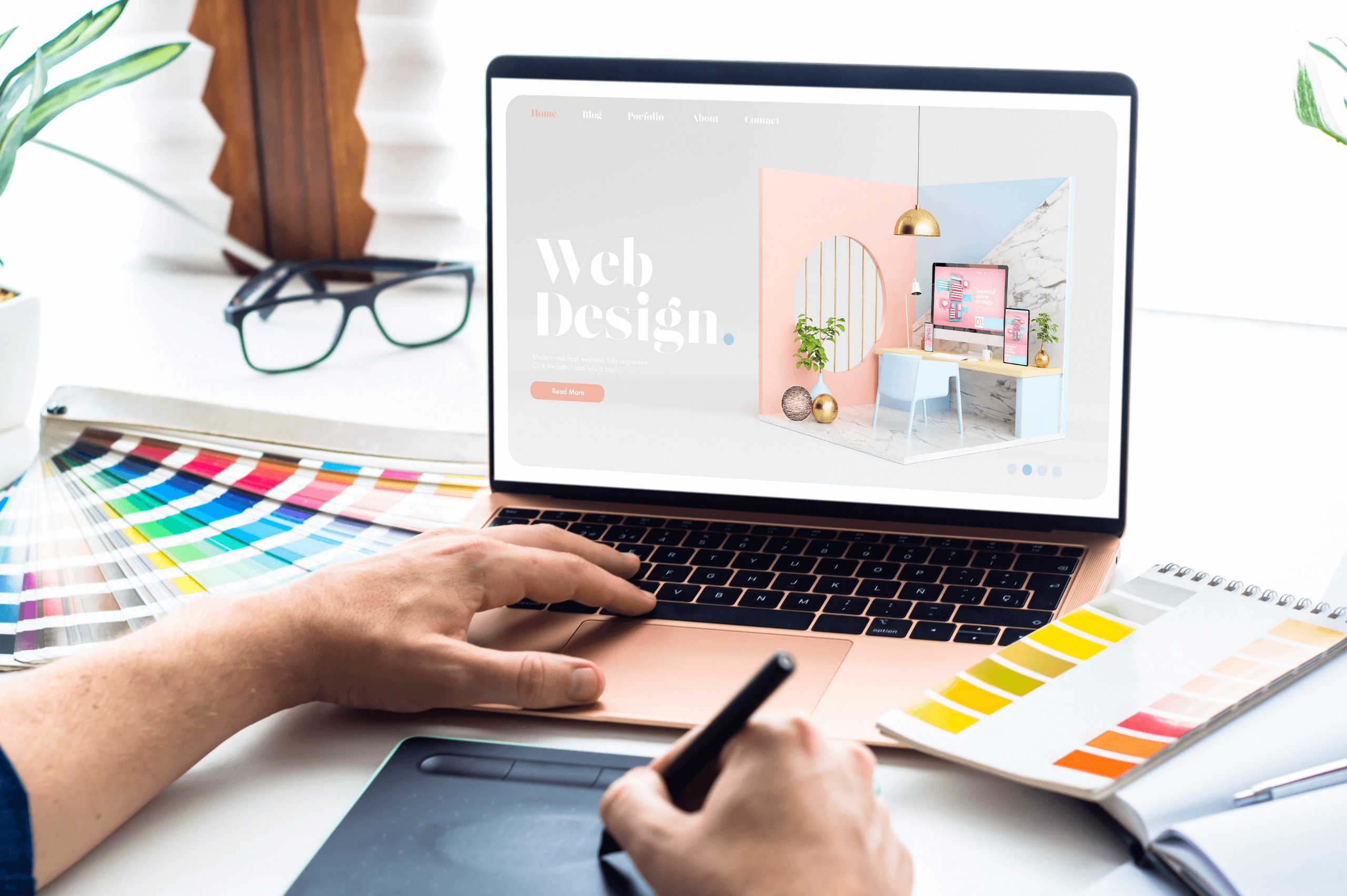
Need a web designer near Spokane? Local web designers provide easier communication and insights into your market. This guide will explain the benefits of hiring locally and help you find the best designer for your project.
Choosing a local web designer enhances communication, accountability, and project success by facilitating face-to-face interactions and local market understanding.
Utilizing online directories, social media, and personal recommendations are effective strategies for finding and evaluating local web designers.
When hiring a web designer, consider their experience, project management process, pricing structure, and the importance of SEO optimization and mobile responsiveness.

Choosing a local web designer offers numerous advantages that can significantly enhance your project. One of the primary benefits is improved communication. Face-to-face interactions facilitate better and more effective communication, ensuring that both parties are on the same page throughout the project. This can lead to a smoother collaboration process and a more tailored website that meets your specific needs.
Local web designers also possess a unique understanding of the regional market. This insight allows them to create websites that effectively target specific demographic groups and resonate with the local audience. Additionally, local designers are more accountable, as clients can easily meet with them in person to discuss project progress and address any concerns.
Engaging with local web designers reduces the risks associated with hiring remote professionals whose reputations may be unclear. Local designers tend to have a stronger commitment to the success of their projects and are more responsive to client needs. They are also more likely to offer hands-on technical support and personalized training, ensuring that you can manage your website effectively after its launch.
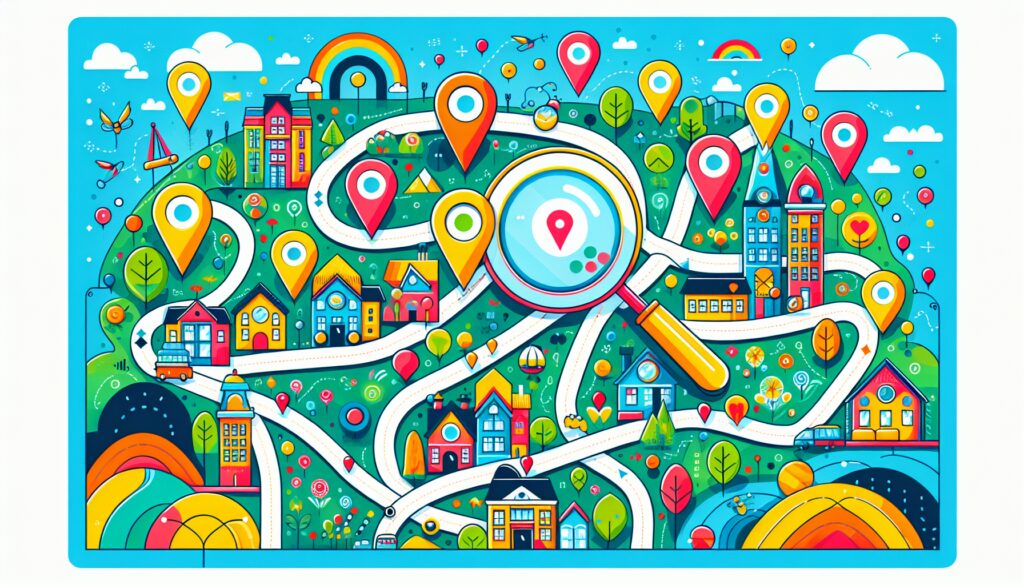
Finding the right web designer near you can feel like a daunting task, but there are several effective strategies you can employ. Utilizing online platforms, such as hiring sites and professional networks, can help you discover local web designers. Directories like Clutch and UpCity are valuable resources that allow you to browse through different options and find web designers based on your location.
Leveraging social media is another powerful tool for finding local web designers. Platforms like Instagram and Twitter often have groups dedicated to web design where you can connect with professionals in your area. Using specific hashtags can also help you locate web designers nearby.
Don’t underestimate the power of personal recommendations. Referrals from friends, colleagues, and business contacts can lead you to trustworthy local web designers who may not have a strong online presence. Combining these methods increases the likelihood of finding the best local web designer for your needs.
Online directories serve as platforms where you can find various web designers based on your location. These directories often allow you to filter results by specific criteria, making it easier to find designers who match your project requirements. Be aware that some designers pay for better placement in search results, which can skew the results.
While focusing on local designers is beneficial, don’t limit yourself too much. Sometimes, expanding your search slightly beyond your immediate area can open up more options and lead to finding a designer who is a perfect fit for your project. Google Reviews are generally considered more reliable for getting insights into the performance of web designers.
Using online directories effectively requires a bit of research and discernment. Checking reviews and comparing portfolios helps you find a web designer who meets your needs and has a proven track record of delivering high-quality work.
Social media platforms are valuable resources for connecting with local web designers. Many designers showcase their work on platforms like Instagram and Twitter, where they use specific hashtags to attract potential clients. Following these hashtags enables you to discover talented designers in your area and view their latest projects.
Joining web design groups on social media can also be beneficial. These groups often include discussions about design trends, job postings, and recommendations for local designers. Engaging in these communities can provide you with insights and connections that you might not find elsewhere.
Social media also allows you to see how designers interact with their audience and clients. This can give you a sense of their communication style and professionalism, helping you make a more informed decision when choosing a web designer.
Asking for recommendations from friends, colleagues, and business contacts can be one of the most effective ways to find a reliable web designer. Personal referrals often lead to discovering talented designers who may not have a strong online presence but have a proven track record of successful projects.
Tapping into your network provides firsthand insights into the designer’s work quality, communication style, and reliability. This can save you time and effort in your search, ensuring that you find a web designer who meets your needs and exceeds your expectations.

Once you’ve identified potential web designers, the next step is to evaluate them thoroughly to ensure they are the right fit for your project. Reviewing portfolios, checking reviews and testimonials, and conducting initial consultations are crucial steps in this process.
A designer’s portfolio should reflect their understanding of design principles and be presented coherently. Checking client reviews and testimonials helps gauge the reliability and satisfaction of previous clients with the web designer’s work. Conducting initial consultations allows you to discuss project needs and ensure good communication with the designer.
By carefully evaluating each candidate, you can make an informed decision and select a web designer who not only has the technical skills but also the ability to understand and execute your vision.
A web designer’s portfolio is a window into their capabilities and style. It should not only showcase visuals but also demonstrate the designer’s problem-solving abilities. Look for a balance of breadth and depth, showcasing a variety of work and detailed case studies.
The way a portfolio is designed can indicate the designer’s attention to detail and their ability to solve design problems. Reviewing a web designer’s portfolio is crucial to understand their style, quality, and whether they fit your project needs.
Analyzing their past work allows you to gauge whether their design approach aligns with your vision.
Checking reviews and testimonials is essential to gauge the reliability and satisfaction level of previous clients. Platforms such as Yelp, Google Reviews, and LinkedIn offer valuable insights into the experiences of other clients.
For example, clients describe Matthew Woodard as professional, knowledgeable, responsive, and trustworthy. Elise’s clients enjoyed an easy and efficient process throughout the project, with clear and timely communication contributing to their satisfaction. Researching client feedback and testimonials will guide your decision-making when selecting the right web designer for your project.
Thoroughly reading reviews ensures that potential web designers have satisfied clients, which is crucial for making informed decisions.
The main goal of a web design consultation is to help clients stand out in their industry and attract their ideal clients. During the initial stages of the web design project, designers provide a fully designed home page within the first few days. Clients feel amazing and excited about the initial work, indicating the designer’s effectiveness and rapport.
Effective communication is critical during these consultations. Designers often engage in a collaborative process with constant feedback from clients. Setting well-defined expectations at the outset is crucial for both clients and designers.
Conducting thorough initial consultations ensures a positive start to your design project.
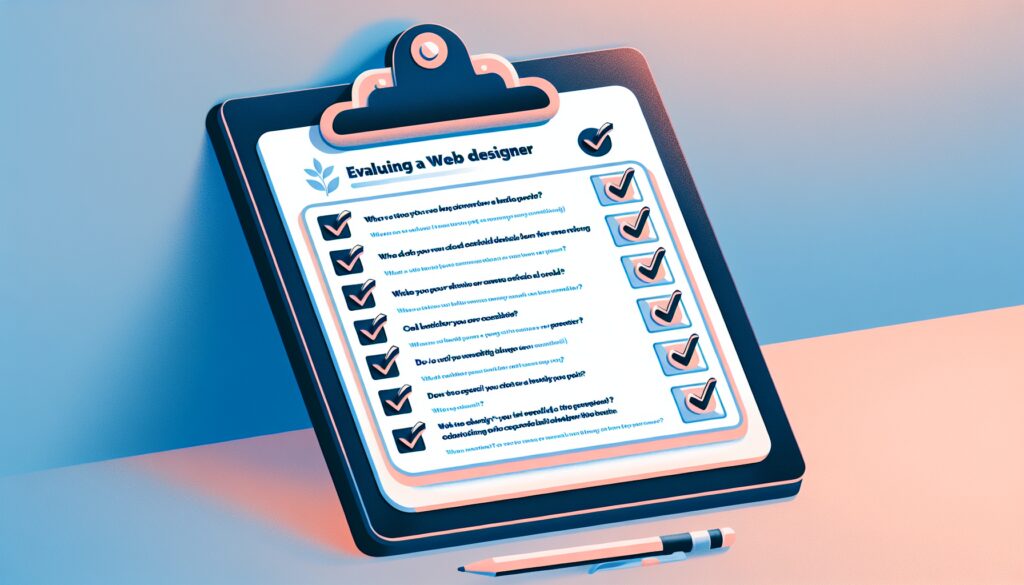
Asking the right questions during initial consultations is essential to ensure you choose the best web designer for your project. It’s important to clarify project needs and evaluate the designer’s communication style. A well-structured initial meeting sets clear expectations and fosters a collaborative working relationship.
You should ask questions about the designer’s experience, project timeline, and pricing to get a comprehensive understanding of their capabilities and how they align with your needs. These questions can help you make an informed decision and ensure a successful collaboration.
When evaluating a web designer, it’s crucial to consider their experience and expertise. Ask about their proficiency in relevant technologies such as CSS, JavaScript, Ruby on Rails, and Python. Understanding whether the designer has a set style or is flexible in their approach can also be important.
Client testimonials often highlight qualities such as responsiveness, professionalism, and project satisfaction. Asking these questions ensures the designer has the technical skills and experience needed for your project.
Clear expectations regarding the project’s timeline are crucial for ensuring successful completion. Understanding the project’s timeline is essential for effective project management and coordination.
A structured designer’s process helps streamline the project and fosters collaboration between all parties involved. Asking about the timeline and process helps ensure the project stays on track and meets your expectations.
Understanding the pricing structure of web design services is essential for staying within budget and ensuring value. The total cost of web design services can vary based on the complexity and functionality required. When hiring a web designer, it is important to ensure that the pricing aligns with your budget.
Elise’s Squarespace Web Design Package includes a fully designed website. It also features expert-level SEO setup. Discussing pricing and deliverables upfront helps avoid surprises and ensures a smooth collaboration.
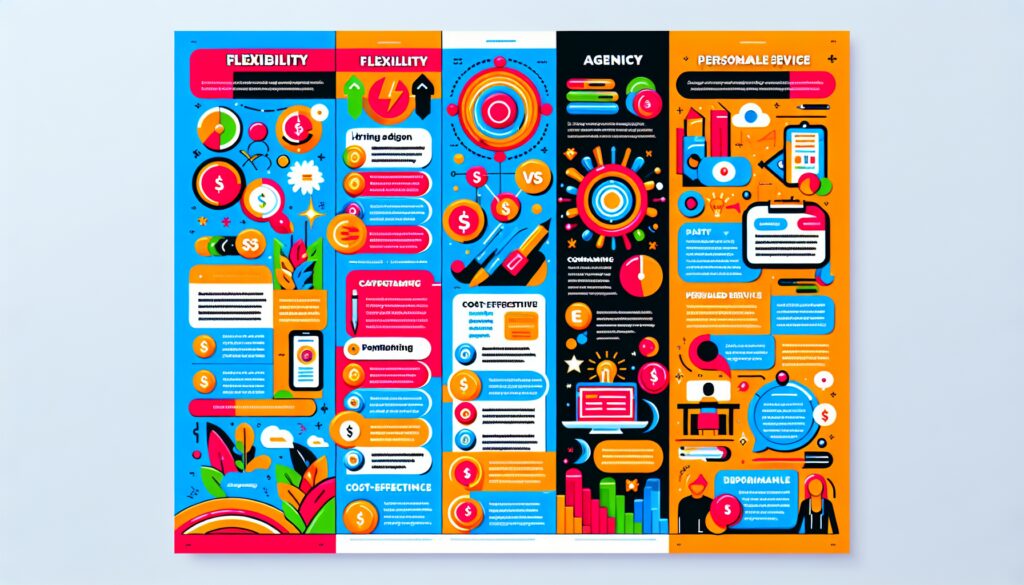
When considering web design services, it’s essential to evaluate the options of freelance web designers and agencies to make an informed decision. Freelance web designers typically have lower operational costs, which allows them to offer more affordable rates compared to agencies. Freelancers also offer greater flexibility in scheduling and quicker response times compared to agencies.
Weighing the cost-effectiveness, flexibility, and personalized service provided by freelance designers helps determine the best fit for your project’s needs.
Freelance web designers can easily adapt to various design styles and technologies, tailoring their work to meet specific client needs. This flexibility allows them to provide a more personalized service compared to larger agencies, which may follow a more standardized approach. For instance, freelancers often take the time to understand your business and its unique requirements, ensuring that the final design aligns with your vision.
With freelancers, personalized communication fosters a clearer understanding of project goals. This direct interaction can lead to a more efficient and effective design process, as the freelancer can quickly respond to any changes or feedback you provide. The result is a custom solution that truly reflects your brand and meets your specific needs.
Moreover, freelancers are often more invested in the success of your project, as their reputation and future business depend on client satisfaction. This level of commitment can translate into a higher quality of service and a more dedicated approach to your web design project.
Hiring a freelance web designer can lead to significant cost savings, especially for small businesses or startups. Freelancers often have lower overhead costs than agencies, which allows them to offer more competitive pricing. This can be particularly beneficial if you have a limited budget but still require high-quality web design services.
Freelancers typically do not carry the expense of employee benefits, which leads to additional cost savings for businesses. The pricing structure for freelance web design is often negotiable, allowing businesses to find arrangements that fit their budget. This flexibility can help you manage costs effectively without compromising on the quality of the final product.
Focusing solely on project needs means freelance web designers limit expenses to essential services without long-term contracts. This means you only pay for what you need, making it easier to scale services based on project size and budget.

SEO optimization plays a crucial role in web design and website development. Effective search engine optimization enhances a website’s visibility, making it easier for potential clients to find it during searches. Achieving a high ranking on search engine results pages significantly increases the likelihood of attracting clicks to your website.
Good SEO practices contribute to a seamless user experience, which is essential for retaining visitors and reducing bounce rates. A mobile-friendly site can positively impact search engine rankings, as Google favors responsive designs. Additionally, incorporating various content types such as videos and infographics can enhance engagement and improve search rankings.
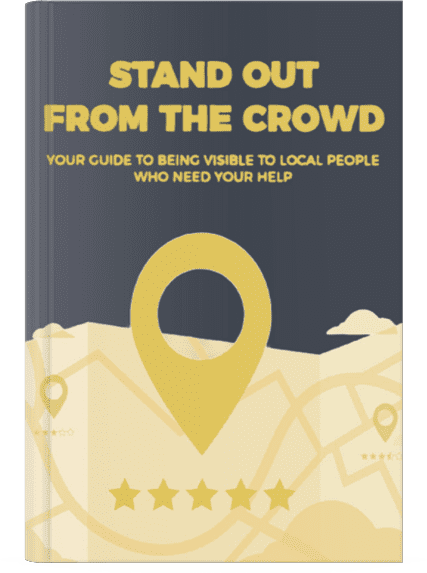
Understanding user intent is essential for creating content that effectively meets search queries and improves SEO. Backlinks from high-authority sites significantly boost a website’s credibility and search rankings. Prioritizing SEO from the start ensures that your website not only looks great but also performs well in search engines.
Ensuring mobile responsiveness is a critical aspect of modern web design and mobile app development. Responsive design enables a website to automatically adjust its content for various screen sizes, enhancing user experience. This reduces the need for zooming and scrolling on mobile devices, making it easier for users to navigate your site.
A responsive website will look and function well on smartphones, tablets, laptops, and desktops. This consistency across devices ensures that all users, regardless of how they access your site, have a positive experience. Verify that your web designer can deliver mobile-responsive design to ensure a seamless user experience across all devices.
Prioritizing mobile responsiveness enhances your website’s usability and accessibility, leading to higher engagement and conversion rates. In today’s digital landscape, having a mobile-friendly website is not just an option—it’s a necessity.
After launching an existing website, ongoing support and maintenance are essential to ensure its performance and address any issues that arise. Regular updates and backups are crucial to protect the website against unexpected issues that could lead to data loss. Website designers often provide video tutorials on how to make edits and updates, ensuring clients can manage their websites effectively.
Clients are encouraged to reach out with questions even after the project is completed, enabling continued support. Responsive design allows for quick updates without the need for changes on multiple sites, enhancing the website’s adaptability. When hiring a website builder, it’s important to check for ease of editing and updating the backend functionalities.
Understanding website maintenance helps you keep your site running smoothly and ensures that it continues to meet the needs of your business and your audience. Regular maintenance can prevent potential problems and ensure that your website remains a valuable asset.
In summary, finding the best web designer near you involves several key steps, from understanding the benefits of hiring local talent to evaluating potential candidates and asking the right questions. By leveraging online directories, social media, and personal recommendations, you can discover talented web designers who can bring your vision to life.
Evaluating portfolios, checking reviews and testimonials, and conducting initial consultations are crucial steps to ensure you choose the right designer for your project. Asking about their experience, project timeline, and pricing helps clarify expectations and foster a successful collaboration. Additionally, understanding the benefits of hiring freelance web designers versus agencies can help you make a cost-effective and informed decision.
Prioritizing SEO optimization, mobile responsiveness, and ongoing website maintenance ensures that your website not only looks great but also performs well and meets the needs of your business and audience. By following these guidelines, you can create a website that stands out in your industry and attracts your ideal clients.
Hiring a local web designer ensures better communication and accountability while offering valuable insights into the regional market, resulting in a more effective and personalized project.
To find web designers near you, use online directories, leverage social media platforms, and seek personal recommendations from friends and business contacts for reliable options.
In a web designer’s portfolio, prioritize a diverse range of projects along with detailed case studies that illustrate their problem-solving skills and attention to detail. This balance of breadth and depth will give you a clear insight into their capabilities.
Hiring a freelance web designer provides greater flexibility, personalized service, and cost-effectiveness, making it easier to tailor the project to your specific requirements. This can lead to a more direct and collaborative working relationship.
SEO optimization is crucial in web design because it boosts a website’s visibility and user experience, leading to higher rankings on search engines and increased click-through rates. Implementing effective SEO strategies ensures your site attracts and retains visitors.
